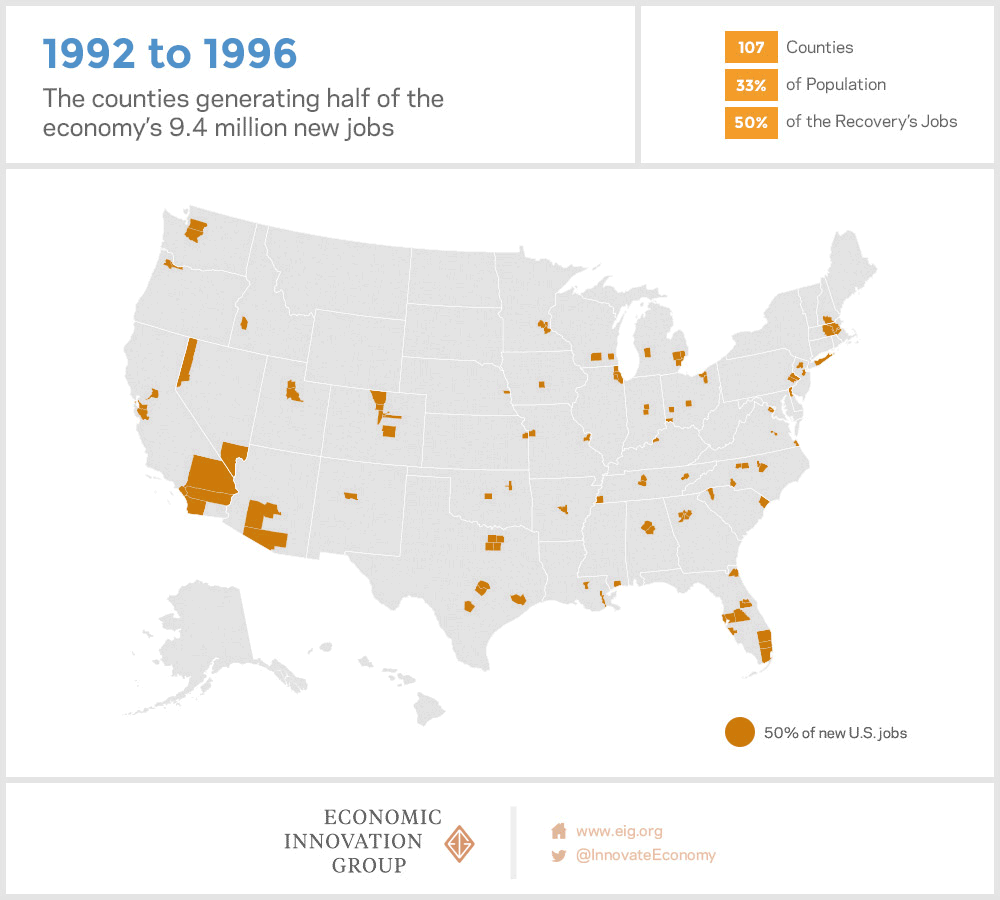 by James A. Bacon
by James A. Bacon
Not only has job creation and new business formation been weak in the current business cycle, it has been more concentrated geographically than in the past. Unfortunately for the Old Dominion, between 2010 and 2014 that concentration did not occur here.
This analysis points to very different futures for American communities, suggesting that the gains from growth have and will continue to consolidate in the largest and most dynamic counties and leave other areas searching for their place in the new economy,” writes the Economic Innovation Group in a new publication, “The New Map of Economic Growth and Recovery.”
The report buttresses an argument familiar to Bacon’s Rebellion readers: that larger metropolitan areas enjoy a significant competitive advantage in the Knowledge Economy. Skilled and educated employees seek large labor markets that provide a diversity of employment opportunities, while corporations seek larger, deeper labor markets that provide access to a diversity of skilled and educated employees. The dynamics of labor markets outweigh factors that confer competitive advantage in the old industrial economy such as access to transportation and natural resources, lower labor costs, low taxes and a low cost of doing business.
In summary: Large metros enjoy a major competitive advantage, smaller metros are teetering on a knife’s edge, and rural areas and small towns are hosed.
“The U.S. economy is becoming far more reliant on a small number of super-performing counties to generate new businesses,” EIG says. “A mere 20 counties accounting for only 17 percent of the U.S. population were responsible for half of the net national increase in business establishments from 2010 to 2014.”
The report does not speculate whether the trend is the result of temporary economic or political factors or is an irreversible long-term trend.

Two trends contribute to the sharp decline in the number of businesses: a higher rate of firm deaths (more companies getting acquired or going out of business) and a collapse in new business formation, as can be seen below.
What could account for these trends? One logical possibility: In a blast of creative destruction associated with the digital economy, a relatively small number of new companies are displacing many established businesses. Another possibility: A wave of economic regulation in recent years has hobbled large swaths of the economy — the banking industry, the Internet, health care, energy, and so on — and has created new economies of scale that favor large, established corporations, encourages mergers and consolidations, and throws up barriers to entry to new firms. Most likely, both are at work.
Weakness in the national economy means that everyone is swimming upstream. Only a small number of metropolitan areas are strong enough to make any progress swimming against the current. Mega-trends favor the mega-metros.
But mega-trends won’t tell the whole story. Some large metros bungle their opportunities though corruption, business-hostile policies and mal-investment of public resources. Some smaller communities buck the broader trends by building defensible economic niches. The news from the EIG report is discouraging, but short-term trends need not dictate our long-term destiny.


Leave a Reply
You must be logged in to post a comment.